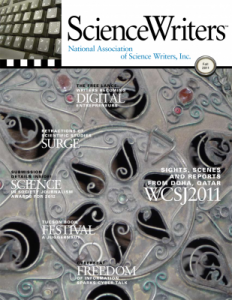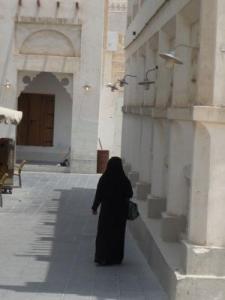By Sarah Curry
We often want to know the history of something (cars, relationships, pets) before we invest in it. Learning about the past helps us understand how things, people, and ideas got to where they are today. But often the history or story behind an idea gets left out of science writing.
The WCSJ2011 panel “Uses of the Past: History of Science as a Tool for Science Journalists” featured four writers who argued that peering into the past can be a vital tool to immerse readers in an idea, discover what’s new about a topic, and provide context for a story.“We have a fascination with science, and we want to tell people just how cool it is (and how it works),” said Deborah Blum, a journalism professor at the University of Wisconsin-Madison and author of several books. Her latest book, The Poisoner’s Handbook: Murder and the Birth of Forensic Medicine in Jazz Age New York, incorporates Blum’s fascination with chemistry.
In an earlier book, Love in Goon Park, Blum crafted a biography out of the idea that love matters.
“We didn’t always believe that,” she explained. As evidence, she cited a popular parenting book in the 1920s that advised mothers to kiss their children just once a year to acknowledge them as a possession. More than that would ruin their “moral fiber.” There are also 20th century psychology books that used the word “proximity” when discussing mother-and-child relationships instead of the word “love.”
It takes a unique individual to change a predominant model of the day, and Love in Goon Park has one in the story of psychologist Harry Harlow, who took on the “impossible challenge of convincing the world that love is a real effect and worth being studied by science,” according to Blum.
“A great way to write a narrative history book is to get your hero in trouble and keep them there,” Blum said. Harlow was perfect as a book subject because he was always in trouble, conducting controversial maternal-separation and social isolation experiments on rhesus monkeys, which demonstrated the importance of care-giving and companionship in social and cognitive development.
Jo Merchant, a freelance writer and editor at New Scientist, agreed. Whether it’s telling the story of an individual involved in a specific scientific event, or taking a reader on an intellectual journey through the development of an idea, history can add depth and value to a piece of science journalism by allowing you to write a chronological narrative.
“I think this kind of story is particularly important for science writing because you’re often dealing with complex technical information that can be quite difficult for the reader to get through,” she said. “So it gives you a way to explain concepts, bit by bit, at the same time having a plot that will make your readers want to keep turning the page.”
Merchant’s recent book, Decoding the Heavens: A 2,000-Year-Old Computer—and the Century-Long Search to Discover Its Secrets, weaves together time periods, adding rich texture, contrast, and context for the reader. But even for shorter pieces, such as one on mummy DNA, she often looks to history. It was a controversial topic, but instead of saying “A says this, B says this,” she opted for a giving a historical perspective on the argument.
“That kind of perspective doesn’t tell you who’s right, but I think it gives you a deeper understanding of what’s going on,” she said. “And it gives you a story, instead of static arguments,” she said.
Holly Tucker, a professor of the history of medicine and early French culture and civilization at Vanderbilt University, got the idea for her latest book while researching the first blood transfusions in the 1660s. Unlike others on the panel, she starts with the historical perspective and then asked: “What does this tell us about today?”“When I start from the early origins, what fascinates me the most is the tensions I see between science and society,” she said.
While it’s hard to imagine modern medicine without blood transfusions, the procedure was feared in the 17th century out of concern that performing transfusions could create hybrid species. Tucker compared those 17th century fears to the modern debate surrounding embryonic stem cell research.
“Whether we’re writing on modern scientific and biomedical innovations, or whether we’re writing stories on specific moments in time in the past, what is the price of a society deciding that certain scientific innovations, and certain practices, should be curtailed?” she asked.
The panel also provided tips on where to look for historical information. Some are familiar research techniques, such as finding original source documents and utilizing online journal archives. But others require being a bit more industrious and practicing old-school journalism. This includes tracking down academic and newspaper articles from the era, as well as personal documents such as letters and diaries.
Getting in touch with descendants of a scientist you are researching can provide unique insights. Also simply picking up the phone and calling a historian of science can be extremely useful, panelists agreed. Visual sources (photos, documentaries) can be equally important, as they can help give you a sense of the time, which will enable you to create rich scenes for your story.
Reto Schneider, deputy editor of NZZ Folio, the magazine of the Neue Zürcher Zeitung in Zürich, Switzerland, believes that the history of science should be a subject in its own right.
“News is stuff people don’t know,” he said. “And Newton is news to most people.”
Schneider spends his time telling readers about wacky experiments that have happened throughout history via the magazine he edits, his blog (weirdexperiments.com), and his book (The Mad Science Book).
In his experience, readers don’t care if the experiment happened 100 years ago, or yesterday. They like to a good story about something they didn’t know. “They like to be surprised,” he said.
For Schneider, science journalism is more about conveying scientific thought rather than simply espousing the latest scientific findings.
“Science, after all, is not the distance from the earth to the sun, or the weight of a T. rex,” he said. “Science is a way to make sense of the world; a method to solve the riddles that surround us everyday. Science is a way of thinking, more than a body of knowledge.”
Whether it’s finding a quirky scientist to follow or figuring out what popular movies have scientific papers named after them (Dances with Lymphocytes), the panel acknowledged that it all comes down to telling an intriguing story.
Writing a beautiful narrative about history allows you to be subversive about the way you communicate science, according to Blum.
“I want to figure out ways to write stories in which people are almost tricked into learning about science,” she said. “Writing a good story which by the end of it, you’re actually going to know a lot about chemistry.”
Miami-based Sarah Curry is an environmental journalist who works in film, print, and on the web. She was a Laura van Dam Travel Fellow to WCSJ2011.



